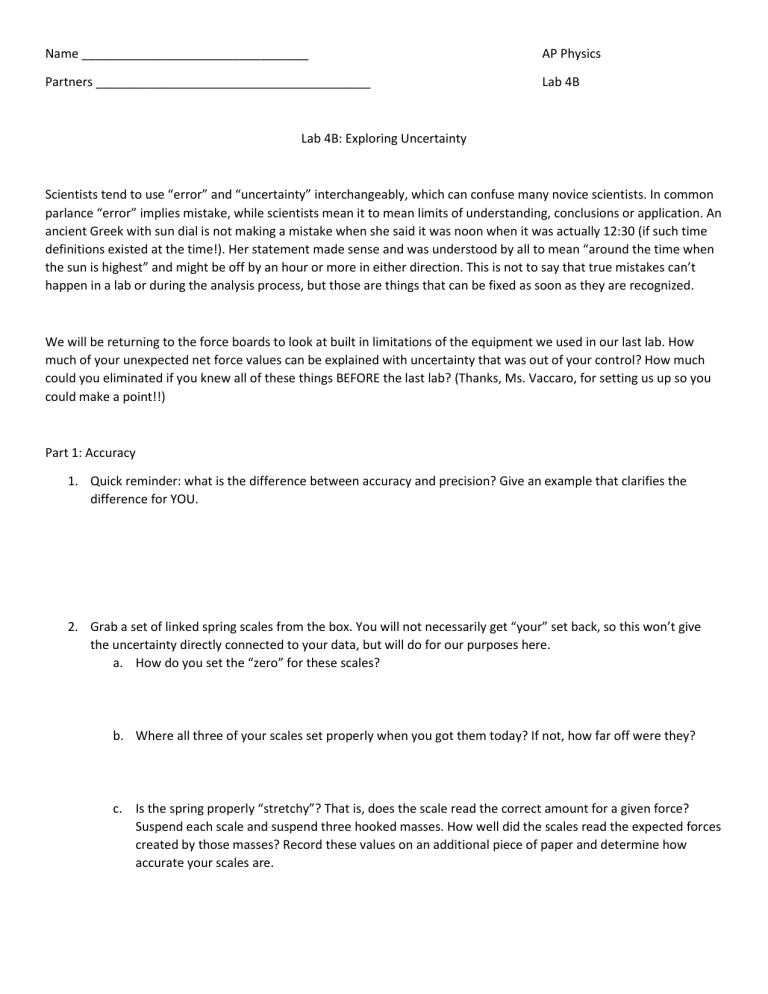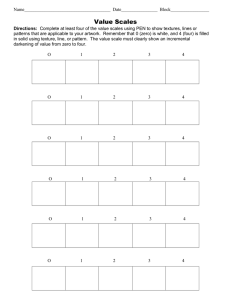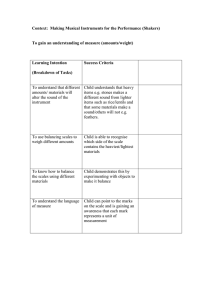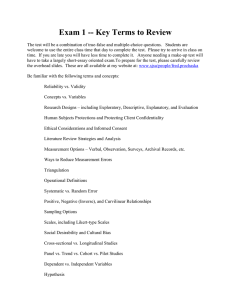
Name _________________________________ AP Physics Partners ________________________________________ Lab 4B Lab 4B: Exploring Uncertainty Scientists tend to use “error” and “uncertainty” interchangeably, which can confuse many novice scientists. In common parlance “error” implies mistake, while scientists mean it to mean limits of understanding, conclusions or application. An ancient Greek with sun dial is not making a mistake when she said it was noon when it was actually 12:30 (if such time definitions existed at the time!). Her statement made sense and was understood by all to mean “around the time when the sun is highest” and might be off by an hour or more in either direction. This is not to say that true mistakes can’t happen in a lab or during the analysis process, but those are things that can be fixed as soon as they are recognized. We will be returning to the force boards to look at built in limitations of the equipment we used in our last lab. How much of your unexpected net force values can be explained with uncertainty that was out of your control? How much could you eliminated if you knew all of these things BEFORE the last lab? (Thanks, Ms. Vaccaro, for setting us up so you could make a point!!) Part 1: Accuracy 1. Quick reminder: what is the difference between accuracy and precision? Give an example that clarifies the difference for YOU. 2. Grab a set of linked spring scales from the box. You will not necessarily get “your” set back, so this won’t give the uncertainty directly connected to your data, but will do for our purposes here. a. How do you set the “zero” for these scales? b. Where all three of your scales set properly when you got them today? If not, how far off were they? c. Is the spring properly “stretchy”? That is, does the scale read the correct amount for a given force? Suspend each scale and suspend three hooked masses. How well did the scales read the expected forces created by those masses? Record these values on an additional piece of paper and determine how accurate your scales are. d. Now, go back and check your “zeroes”, did stretching the spring multiple times shift your calibration? 3. Now to consider the angles. a. What built in limitations are there for choosing angles? b. Do those limitations impact your results in this lab? Why or why not? (limited values do not necessarily create uncertainty if those values are correct, but should always be noted!) c. We assumed that the notches were 10 degrees apart, but we didn’t measure them. Was that a good assumption? Explain how you checked that assumption and your observations. d. How much “wiggle room” is there in each notch? Can you make a meaningful change in your angle measurement in the same notch? e. What can you conclude about accuracy and precision in your angle measurements? SET UP A NEW EQUILIBRIUM CONFIGURATION ON YOUR BOARD. 4. While the spring can stretch over an infinite number of values (making it “continuous” rather than “discrete”), the chain that we use to hook over the edge has limited number of positions. a. What level of precision is established by the scale on the spring scale? b. What level of significant figures and degrees of precision are set by the spring scale? c. Try to read one of the spring scales from various angles? Do you get a different reading? How much does it change, if any? This step is checking for parallax error. d. Change the setting on one of your scales by one link of the chain, then two and three links. Record your data on the same attached sheet you used before. i. How much did it change the force readings? ii. Is there any pattern? iii. Return the scale to the original setting and repeat with another scale. Note your observations. iv. Can you change the position of any of the chains and still create a centered equilibrium for a given set of angles? If you CAN/COULD change the position, what does/would that imply about the accuracy of your force measurement? v. Do having limited options for force settings create uncertainty in your work or do limits in the sensitivity of the equipment cause problems or both? Explain. vi. Can you create a centered equilibrium with different force values without changing the angles? You may adjust as many chains as needed. Note your observations. vii. Explain why your observations in the last question make physical sense. 5. Return your board to a centered equilibrium. Friction between the board and the scales create additional forces on the system. a. Which way do the forces of friction act in this system? Explain and include a sketch(s). b. Can you use the force of friction to change the force readings on your scales? If so, b y how much? c. Is/would this affecting your accuracy or your precision? 6. Summarize the various aspects of the equipment that might have affected your results in the first part of the lab. Quantify those affects as clearly as possible.




